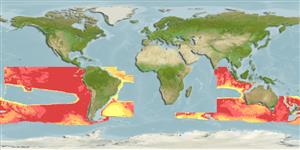Eremicaster pacificus (Ludwig, 1905)
| Native range | All suitable habitat | Point map | Year 2050 |

|
| This map was computer-generated and has not yet been reviewed. |
| Eremicaster pacificus AquaMaps Data sources: GBIF OBIS |
Google image |
No photo available for this species.
Classification / Names Κοινά ονόματα | Συνώνυμα | CoL | ITIS | WoRMS
Asteroidea | Paxillosida | Porcellanasteridae
Environment: milieu / climate zone / εύρος βάθους / distribution range Οικολογία
βαθύβιο(ς); εύρος βάθους 1550 - 7000 m (Αναφ. 77113). Tropical; 10°N - , 26°W - (Αναφ. 77113)
Distribution Χώρες | Περιοχές FAO | Οικοσυστήματα | Παρουσίες | Εισαγωγές
Cosmopolitan deep sea from Eastern Pacific to Mid-Atlantic. Tropical to subtropical.
Length at first maturity / Μέγεθος / Weight / Age
Γεννητική Ωρίμανση: Lm ? range ? - ? cm
Life cycle and mating behavior Γεννητική Ωρίμανση | Αναπαραγωγή | Γεννοβολία | Eggs | Γονιμότητα | Larvae
Main reference
Αναφορές | Συντονιστής | Συνεργάτες
Madsen, F.J. 1952 Echinoidea, Asteroidea and Ophiuroidea from depths exceeding 6000 meters. Galathea Report: Scientific Results of the Danish Deep-Sea Expedition Round the World 1950-52, 2:23-32. (Αναφ. 77113)
IUCN Red List Status
(Αναφ. 130435: Version 2025-1)
CITES status (Αναφ. 108899)
CMS (Αναφ. 116361)
Threat to humans
Human uses
| FishSource |
Εργαλεία
Περισσότερες πληροφορίες
Σύσταση δίαιτας
Κατανάλωση τροφής
Θηρευτές
Max. ages / sizes
Length-weight rel.
Length-length rel.
Length-frequencies
Mass conversion
Αφθονία
Διαδικτυακές πηγές
BHL | BOLD Systems | CISTI | DiscoverLife | FAO(Publication : search) | Fishipedia | GenBank (genome, nucleotide) | GloBI | Gomexsi | Google Books | Google Scholar | Google | PubMed | Δέντρο Ζωής | Wikipedia (Go, αναζήτηση) | Zoological Record


